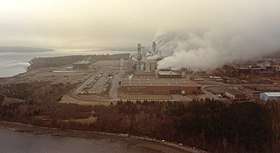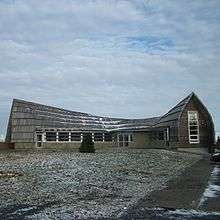Boat Harbour, Nova Scotia

Boat Harbour is a body of water on the Northumberland Strait in Pictou County, Nova Scotia.[1] Originally a tidal bay, construction of an effluent treatment facility in the 1960s led to it becoming a polluted lake and the source of ongoing environmental concern. Treated water takes about 30 days to reach the Northumberland Strait. Since the treatment system began operation in 1967, Boat Harbour has become polluted with dioxins, furans, chloride, mercury and other toxic heavy metals.[2] It is considered to be one of Nova Scotia's worst cases of environmental racism.[3]
Boat Harbour is fed by several freshwater streams from spruce woodlands.[4] Known as A'se'k (IPA [ɑːseːk]) in the Mi'kmaq language, it was historically used by First Nations people for fishing, clam digging, hunting and recreation,[5] as well as a harbour for boats used to fish in the Northumberland Strait.[4] Pictou Landing First Nation have their main reserve, Fisher's Grant 24, adjacent to Boat Harbour, and two other unpopulated reserves nearby.
Effluent treatment facility
In the 1960s a kraft pulp mill was constructed by Scott Paper Company at Abercrombie Point, 4 km (2.5 mi) to the west. Keen to promote economic growth, the provincial government led by Robert L. Stanfield agreed to take responsibility for effluent leaving the mill for a period of thirty years, and turned Boat Harbour into a settling pond by constructing a dam across its mouth. Pictou Landing First Nation were compensated $65,000 for lost fishing opportunities and future use of the Harbour. As soon as the mill began operation all aquatic life died and the water level rose by 2–3 m (6–10 ft),[4] flooding 12 hectares (30 acres) of reserve lands.[6] In 1971 two settling ponds and an aerated stabilisation basin were constructed where the effluent entered the lagoon. In 1975 a pipeline replaced the ditch that effluent flowed through before entering the system.[4]

Canso Chemicals, a chlor-alkali facility situated on the mill property from 1971 to 1992, also used Boat Harbour to dispose of its effluent. It produced chlorine, caustic soda, and hydrogen for use at the mill.[7][8] During the 1970s the plant was unaccountably losing several tons of mercury each year, with a peak loss of five tons in 1975.[9] This loss has never been resolved, leading to concerns that it may have found its way into Boat Harbour.[10]
Settled material from the facility is normally dredged and buried off-site, but some has been dried and burned in the mill's power boiler under 'test permits'.[11]

In 1977 the Pictou Landing Band began considering legal options, but it wasn't until 1986 that they filed against the federal government, their position strengthened by the 1984 case of R v Guerin in which the Supreme Court of Canada confirmed the government's fiduciary duty to status Indians. In 1993 the federal government settled out of court for $35 million, some of which was paid to individual band members and some to a trust fund for future use. In 1995 the provincial government agreed to extend its contract with the mill to handle the effluent, and in return to handover nearby Crown Lands to the band. It also agreed to close the facility in 2005 and return the harbour to its natural condition.[4]
In 1997 the mill was taken over by Kimberly-Clark and in 2003 they agreed with the Band to extend treatment beyond the 2005 deadline, by piping effluent directly from the aerated settling pond to the Northumberland Strait where it would be released on the ebb tide, and to return Boat Harbour to a tidal state. However, the mill was purchased in 2004 by Neenah Paper who were not inclined to spend capital on water treatment, and following concerns from the Department of Fisheries and Oceans over the environmental consequences of the pipeline, that plan was cancelled in 2005. In 2008 the province decided to extend the discharge license on a month-by-month basis. The following month the mill was purchased by Northern Pulp, a subsidiary of Asia Pulp and Paper, an arm of the Indonesian conglomerate Sinar Mas.[12] The Progressive Conservative government of the time agreed to close Boat Harbour and build a new facility, but when the New Democrats came to power in 2009 negotiations ceased. Following that government's decision to provide $90 million assistance to the mill to purchase woodland and improve air treatment systems but do nothing about Boat Harbour, the First Nation filed an action in the Supreme Court of Nova Scotia.[4]
In June 2014 the pipeline carrying effluent from the mill to the treatment facility ruptured,[13] causing 47 million litres (10 million gal) of effluent to spill into a wetland and thence to the East River and Pictou Harbour. The mill owners were charged under the Fisheries Act and fined $225,000 which was to be distributed equally to three conservation organizations.[14] Following protests by the First Nation over this spill, the Provincial Government passed the Boat Harbour Act 2015 to the effect that effluent treatment must cease no later than January 31, 2020. A Provincial Crown Corporation, Nova Scotia Lands, Inc. is responsible for remediation of the site.[15] A pilot project was undertaken in 2017 to test options for handling the clean up which will involve removing an estimated 350,000 cubic metres (12,000,000 cu ft) of contaminated material and returning the lagoon to a tidal estuary at an estimated cost of $133 million.[16]
References
- ↑ "Boat Harbour". Geographical Names Board of Canada. Natural Resources Canada. Retrieved 7 October 2017.
- ↑ "Pictou Landing First Nation and mill wastewaster in Boat Harbour, NS". The Council of Canadians. 7 October 2011. Retrieved 8 October 2017.
- ↑ Donovan, Moira (Mar 16, 2016). "Nova Scotia group maps environmental racism". CBC News. Retrieved 17 October 2017.
- 1 2 3 4 5 6 Clancy, Peter (2014). Freshwater Politics in Canada. Univ of Toronto Pr Higher education. pp. 27–35. ISBN 9781442609266. Retrieved 8 October 2017.
- ↑ "The Pictou Landing First Nation: Reclaiming the A'se'k Estuary" (PDF). East Coast Environmental Law Association. Retrieved 8 October 2017.
- ↑ "Roseanne Skoke on Pictou Landing Indian Band Agreement Act". House of Commons. 16 February 1995. Retrieved 9 October 2017.
- ↑ "The Effluent Treatment System at Boat Harbour". Dillon Consulting Limited. Archived from the original on 25 December 2017. Retrieved 25 December 2017.
- ↑ "Acts & Regulations - Compliance with Chlor-Alkali Mercury Regulations, 1986-1989: Status Report". www.ec.gc.ca. Government of Canada, Environment and Climate Change. Retrieved 25 December 2017.
- ↑ "Plant told to cut mysterious mercury losses". The Montreal Gazette. Canadian Press. 20 June 1977. Retrieved 25 December 2017.
- ↑ Taylor, Roger (April 17, 2015). "Boat Harbour cleanup far from simple". Chronicle Herald. Retrieved 25 December 2017.
- ↑ Howe, Miles (10 February 2012). "Where It Goes, Somebody Knows..." Halifax Media Co-op. Retrieved 17 October 2017.
- ↑ Summers, Ken (March 6, 2015). "Heat Turns Up on Northern Pulp". Halifax Media Co-op. The Media Co-op. Retrieved 19 November 2017.
- ↑ Beswick, Aaron (10 June 2014). "Effluent spill shuts down Northern Pulp mill". The Chronicle Herald. Retrieved 17 October 2017.
- ↑ "R. v. Northern Pulp Nova Scotia Corporation, 2016 NSPC 29 (CanLII)". CanLII. Federation of Law Societies of Canada. Retrieved 16 October 2017.
- ↑ "Boat Harbour, Pictou County". NSLands. Retrieved 9 October 2017.
- ↑ Withers, Paul (Jun 20, 2017). "Officials with $133M Boat Harbour cleanup get first look at contaminated sediment". CBC News. Retrieved 9 October 2017.
Further reading
- "Boat Harbour: On toxic pond". The Coast. University of King's College Journalism Students. 23 April 2009. Retrieved 9 October 2017.
- Daniel Paul. "Chief Raymond Francis: Boat Harbour Indian Reserve Land Claim". www.danielnpaul.com. Retrieved 9 October 2017.
- Rudderham, Stacey (2017), "ˈnim bē - Pictou Mill", YouTube, retrieved 9 December 2017
- "Pictou County's Boat Harbour from 1988", YouTube, Fifth Estate, 1988, retrieved 9 December 2017
- "A'se'k - The Other Room (Boat Harbour)", YouTube, Ni'nwey Video Productions, 2014, retrieved 9 December 2017
- Baxter, Joan (2017). The Mill. Halifax, Nova Scotia: Nimbus Publishing. ISBN 9781988286174.
External links
Coordinates: 45°39′46″N 62°39′07″W / 45.662674°N 62.651868°W